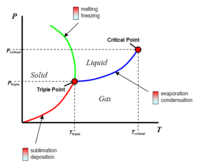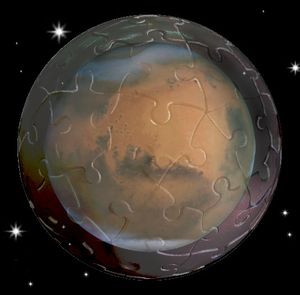Terraforming
Terraforming, or Earth-shaping, is a theoretical process of modifying a planet's atmosphere to make it habitable for humans. In the case of Mars, terraforming would require artificial thickening of the atmosphere to intensify the process of greenhouse warming (heating the frozen landscape), ice melting to increase the H2O content of the atmosphere (creating water clouds) and greatly increasing the O2 density to ultimately make the atmosphere breathable.
Contents
Mars and the "Triple Point" of water

Presently, ice on Mars sublimes as the atmospheric pressure is so low, ice bypasses the liquid phase when heated. Sublimation occurs allowing ice to turn directly into gas (steam). One of the main challenges for future terraforming efforts would be to increase the atmospheric pressure significantly so water can exist as a liquid on the surface of Mars. The atmospheric pressure and ambient temperature will therefore need to be greater than the triple point of water (thereby existing as ice, liquid and gas). This is just above 0C and 600 Pa. Mars atmospheric pressure is already above 600 Pa. However, close to the triple point, water takes very little energy to turn into a gas, so higher pressures would be required in practice.
Methods
A life supporting atmosphere needs to contain a "buffer gas", such as nitrogen. Mars is currently lacking in nitrogen, but nitrogen could be sourced from Venus, Saturn's moon Titan, or from comets. Mars could be warmed up using greenhouse gases such as perfluorocarbons, which are stable in the atmosphere for long periods of time. Mirrors could be placed in orbit to increase the amount of insolation Mars receives.
Other greenhouse gasses include sulfur hexafluoride and 1,1,1-Trichloro ethane. These are very stable and highly effective greenhouse gasses. Use of such gasses to warm the atmosphere would allow the Carbon dioxide frozen into the polar caps and some of the water to evaporate adding to the mass of the atmosphere.If 4 hundredths of a microbar of manufactured greenhouse gas is needed to warm Mars to the point of runaway greenhouse effect, then a mass of manufactured greenhouse gasses equal to about 5.73 times the cargo capacity of the Edmund Fitzgerald every week for twenty years would be required for the project.
Pioneer Organisms
Certain organisms, such as archaea, lichen, and tardigrades have been proven capable of surviving extreme environments, such as the vacuum of space. They could gain a foothold on the martian surface after minimal terraforming. The byproducts of their metabolism would contribute to the terraforming efforts.
Long term prospects
The ultimate results of terraforming are disputed. Terraforming may have only a temporary effect, even if the effect lasts for some hundred or thousand years. Eventually, the solar wind may carry away most of the new atmosphere due to the insufficient magnetic fields of Mars. It has been suggested that the cost of terraforming a planet would be prohibitive, however to a growing population on the surface of that planet it would most likely be considered a normal colonial function to ensure that daily colonial endeavours have a positive effect on the atmosphere. Artificial magnetic fields might also be created around Mars to reduce atmospheric losses to space.
Partial terraforming
| Parameter | Mars[1], mbar | Plants[2], mbar | Humans, mbar |
|---|---|---|---|
| Total pressure | 0.30-11.55 (6 average) | >10 | >250 |
| Carbon dioxide (CO2) | 0.29-11.09 (5.76 average) | >0.15 | <10 |
| Nytrogen (N2) | 0.01-0.22 (0.114 average) | >1-10 | - |
| Oxygen (O2) | <0.015 | 1 | >130 |
When full terraforming to make Mars atmosphere suitable for breathable condition for humans can take around 100,000 years, transformation to the atmosphere suitable to plants can take time from 100 years to several thousands. Current requirements for plants for growth on Mars are based on the boiling point of the water. Mars polar caps have enough amount CO2 to provide 100 mbar additional atmospheric pressure enough for the sustainable growth condition to the plants - it's a relatively simple and fast way to fill the atmosphere. To make using pressure suit unnecessary for humans atmosphere pressure need to rise at least 250 mbar (which are composed from of 50 mbar CO2 and 60 mbar water vapour pressure on the lungs and the 130 mbar minimal requirement oxygen pressure), it's requirement extraction some part of the regolith deposits of the CO2 which are estimated in 300 mbar additional pressure, but but require significantly greater time to extract.
References
- ↑ Mahaffy, P. R.; Webster, C. R.; Atreya, S. K.; Franz, H.; Wong, M.; Conrad, P. G.; Harpold, D.; Jones, J. J.; Leshin, L. A.; Manning, H.; Owen, T.; Pepin, R. O.; Squyres, S.; Trainer, M.; Kemppinen, O.; Bridges, N.; Johnson, J. R.; Minitti, M.; Cremers, D.; Bell, J. F.; Edgar, L.; Farmer, J.; Godber, A.; Wadhwa, M.; Wellington, D.; McEwan, I.; Newman, C.; Richardson, M.; Charpentier, A. - Abundance and Isotopic Composition of Gases in the Martian Atmosphere from the Curiosity Rover, Nature 341, pp. 263-266. DOI:10.1126/science.1237966
- ↑ Christopher P. McKay, Owen B. Toon & James F. Kasting - Making Mars habitable, Nature 352, pp. 489-496. DOI:10.1038/352489a0







